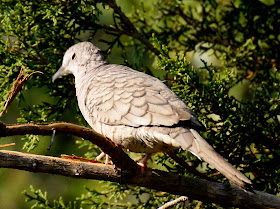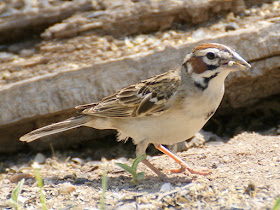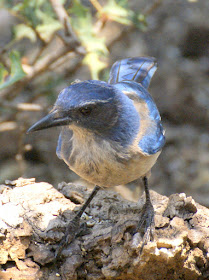.
.
Jeff Mohamed blogs about birds and other wildlife in the Houston area - and occasionally farther afield.
Friday, May 31, 2013
Wednesday, May 29, 2013
South Llano River State Park Again
.
On my way into the park early on Monday morning, I had to stop to let a couple of Wild Turkeys cross the road.
Perhaps because it was still cool, the Laura and Agarita blinds didn't produce any great sightings, although there were quite a few birds at both stations.
Cottontails and jackrabbits popped up along the trails. This cottontail stayed motionless, even when I came within four feet of it.
This jackrabbit also seemed unconcerned by my presence.
After 90 minutes I drove back to the motel to pick up Dee and we headed out together for our final visit to the park.
As the Laura blind was quiet, we soon moved on to the Agarita blind. On the trail we stopped to admire a Ladder-backed Woodpecker.
When I planned our visit to Junction, I had assumed that I would do a lot of birding: that is, I would spend much of the time walking trails and looking for birds, and particularly new birds such as Green Kingfisher, Black-capped Vireo and Zone-tailed Hawk. As it turned out, though, it was so much fun watching the birds at the blinds that I did hardly any real birding.
However, I did get lucky with new birds in our last hour or so at the park.
On the way to the Agarita Blind, I stopped to check out a Turkey Vulture in case it was actually a Zone-tailed Hawk. I'd done the same with every one of the scores of Vultures that we'd seen on the weekend but to no avail. This time was different, though!
After this, we stayed watching the bird activity at Agarita until our planned departure time of 11:30.
There were Painted Buntings, of course.
A Magnolia Warbler made a very brief appearance but a Wilson's Warbler (below) stayed to bathe.
At 11:30 we were just getting into our the car to head back to Houston when we were approached by a man who asked what birds we'd seen. We chatted for a minute and I mentioned that we'd missed seeing the Black-capped Vireo. "Oh, I can show you where two are nesting," he told us. It turned out that he was Rhandy Helton, Junction's resident birding expert.
Rhandy led us a 2-3 hundred yards past the Agarita blind and pointed out a Black-capped Vireo nest within four feet of the trail.
As we examined the nest, a Black-capped Vireo scolded us from a nearby tree. Then its mate appeared also. Unfortunately, both birds were too elusive for me to get a decent photo. Oh, well, maybe next time. And there will be a next time. In fact, we're already talking about going back to South Llano River SP in September. But next time we're going to stay longer and to camp, so that we can really explore this marvellous park. And, of course, so that I can finally get to see a Green Kingfisher.
.
On my way into the park early on Monday morning, I had to stop to let a couple of Wild Turkeys cross the road.
Perhaps because it was still cool, the Laura and Agarita blinds didn't produce any great sightings, although there were quite a few birds at both stations.
Cottontails and jackrabbits popped up along the trails. This cottontail stayed motionless, even when I came within four feet of it.
This jackrabbit also seemed unconcerned by my presence.
After 90 minutes I drove back to the motel to pick up Dee and we headed out together for our final visit to the park.
As the Laura blind was quiet, we soon moved on to the Agarita blind. On the trail we stopped to admire a Ladder-backed Woodpecker.
When I planned our visit to Junction, I had assumed that I would do a lot of birding: that is, I would spend much of the time walking trails and looking for birds, and particularly new birds such as Green Kingfisher, Black-capped Vireo and Zone-tailed Hawk. As it turned out, though, it was so much fun watching the birds at the blinds that I did hardly any real birding.
However, I did get lucky with new birds in our last hour or so at the park.
On the way to the Agarita Blind, I stopped to check out a Turkey Vulture in case it was actually a Zone-tailed Hawk. I'd done the same with every one of the scores of Vultures that we'd seen on the weekend but to no avail. This time was different, though!
After this, we stayed watching the bird activity at Agarita until our planned departure time of 11:30.
There were Painted Buntings, of course.
A Magnolia Warbler made a very brief appearance but a Wilson's Warbler (below) stayed to bathe.
At 11:30 we were just getting into our the car to head back to Houston when we were approached by a man who asked what birds we'd seen. We chatted for a minute and I mentioned that we'd missed seeing the Black-capped Vireo. "Oh, I can show you where two are nesting," he told us. It turned out that he was Rhandy Helton, Junction's resident birding expert.
Rhandy led us a 2-3 hundred yards past the Agarita blind and pointed out a Black-capped Vireo nest within four feet of the trail.
As we examined the nest, a Black-capped Vireo scolded us from a nearby tree. Then its mate appeared also. Unfortunately, both birds were too elusive for me to get a decent photo. Oh, well, maybe next time. And there will be a next time. In fact, we're already talking about going back to South Llano River SP in September. But next time we're going to stay longer and to camp, so that we can really explore this marvellous park. And, of course, so that I can finally get to see a Green Kingfisher.
.
Monday, May 27, 2013
South Llano River SP
.
As we approached the Visitor Center, we noticed that a Purple Martin house there was busy with both Purple Martins and the inevitable House Sparrows. The front porch of the Center had several hummingbird feeders that were attracting large numbers of both male and female Black-chinned Hummingbirds.
The Visitor Center staff were very friendly and they showed us how to get to the other three bird blinds.
We started by visiting the Agarita Blind, which is just a minute's walk behind the Visitor Center. The birds here were mainly the same species as we had seen at the first blind, and Painted Buntings were again the stars of the show.
However, there were a few different birds, including a female Summer Tanager.
A male Indigo Bunting was another new bird for the trip.
So, too, was an Inca Dove.
I was a little surprised to see a Pine Siskin.
The water feature at this blind offered several bathing areas for the birds, and the latter took full advantage of them. The bathers included Field Sparrow, Northern Cardinal and Painted Bunting.
A White-eyed Vireo dashed in and out of the water half-a-dozen times but never stayed long enough for me to get a photo. Another bird that I missed photographing was a Bewick's Wren, which perched and sang briefly from a tree top.
A Yellow-breasted Chat stayed around longer and took a leisurely bath.
The final two blinds were much less busy with birds. However, we would probably have been thrilled by them if we hadn't been spoiled by the number and variety of birds at the first two blinds.
Back at Laura's Blind we watched a Golden-fronted Woodpecker fly in to drink.
As it was now getting very hot, we left the park, pausing to let a Wild Turkey cross the road ahead of us. We drove into Junction and had an excellent Mexican lunch. Then we checked into our motel, the Legends Inn. It turned out to be as comfortable as on-line reviews had led us to expect.
Dee decided to rest but I wanted to explore the area, so I drove to the city park. I scoured the river banks with binoculars, looking unsuccessfully for Green Kingfishers. There were several other birds, though, including Eastern Wood-Pewee, Eastern Bluebirds, Western Kingbirds and Bronzed Cowbirds.
A group of maybe a hundred Black Vultures were resting under trees just outside the park and it was odd to see one of them cross to wade in the water in the company of several exotic geese.
A Great Blue Heron looked on.
The following day we were due to head home to Houston. However, I planned to return to do some early morning birding at South Llano River SP and then to take Dee back there for another couple of hours before setting off down I-10.
.
As we approached the Visitor Center, we noticed that a Purple Martin house there was busy with both Purple Martins and the inevitable House Sparrows. The front porch of the Center had several hummingbird feeders that were attracting large numbers of both male and female Black-chinned Hummingbirds.
The Visitor Center staff were very friendly and they showed us how to get to the other three bird blinds.
We started by visiting the Agarita Blind, which is just a minute's walk behind the Visitor Center. The birds here were mainly the same species as we had seen at the first blind, and Painted Buntings were again the stars of the show.
However, there were a few different birds, including a female Summer Tanager.
A male Indigo Bunting was another new bird for the trip.
So, too, was an Inca Dove.
I was a little surprised to see a Pine Siskin.
The water feature at this blind offered several bathing areas for the birds, and the latter took full advantage of them. The bathers included Field Sparrow, Northern Cardinal and Painted Bunting.
A White-eyed Vireo dashed in and out of the water half-a-dozen times but never stayed long enough for me to get a photo. Another bird that I missed photographing was a Bewick's Wren, which perched and sang briefly from a tree top.
A Yellow-breasted Chat stayed around longer and took a leisurely bath.
The final two blinds were much less busy with birds. However, we would probably have been thrilled by them if we hadn't been spoiled by the number and variety of birds at the first two blinds.
Back at Laura's Blind we watched a Golden-fronted Woodpecker fly in to drink.
As it was now getting very hot, we left the park, pausing to let a Wild Turkey cross the road ahead of us. We drove into Junction and had an excellent Mexican lunch. Then we checked into our motel, the Legends Inn. It turned out to be as comfortable as on-line reviews had led us to expect.
Dee decided to rest but I wanted to explore the area, so I drove to the city park. I scoured the river banks with binoculars, looking unsuccessfully for Green Kingfishers. There were several other birds, though, including Eastern Wood-Pewee, Eastern Bluebirds, Western Kingbirds and Bronzed Cowbirds.
A group of maybe a hundred Black Vultures were resting under trees just outside the park and it was odd to see one of them cross to wade in the water in the company of several exotic geese.
A Great Blue Heron looked on.
The following day we were due to head home to Houston. However, I planned to return to do some early morning birding at South Llano River SP and then to take Dee back there for another couple of hours before setting off down I-10.
.
Friday, May 24, 2013
An Exceptional Park
.
Sunday morning we set off on the 100+ mile drive from Uvalde to Junction, where we wanted to do some birding in the South Llano River State Park.
After we crossed the South llano River just inside the park, we noticed that an adjacent field had several exotic animals, including some beautiful antelopes. We were told later than the owner of that piece of land breeds a variety of exotic antelope and deer.
A couple of hundred yards further along the entrance road we stopped at Laura's Blind, one of four excellent and comfortable bird blinds spread around the park. Each blind looks onto a small area where park staff scatter around bird seed every morning and afternoon. Each area also has a water feature, which really draws in the birds.
Half-a-dozen male Painted Buntings were the first birds to catch our eye. How could these beautifully colored birds not be the first thing you look at!
There were female Painted Buntings, too, of course.
Mixed in with the Buntings were House Finches and Lark Sparrows (below).
Field Sparrows seemed tiny in comparison to the Lark Sparrows.
Black-crested Titmice made frequent trips to pick up seeds.
White-winged Doves wandered about on the ground and cooed from the trees, while three Brown-headed Cowbirds (below) came in to feed.
A couple of Western Scrub Jays made a dramatic entrance although, remarkably for Scrub Jays, they were almost totally silent.
A few minutes later saw the arrival of one of species I'd most wanted to see, a Black-throated Sparrow. What stunning little birds these are!
There was so much activity at this blind that it was really difficult to tear ourselves away from it. However, we decided we should head to the Visitor Center to renew our annual state park and then check out other parts of the park.
As we left the blind, a large snake was sitting by the path with its head reared up.
We'd been in the park less than an hour and already it had turned out to be well worth the long drive from Houston.
.
Sunday morning we set off on the 100+ mile drive from Uvalde to Junction, where we wanted to do some birding in the South Llano River State Park.
After we crossed the South llano River just inside the park, we noticed that an adjacent field had several exotic animals, including some beautiful antelopes. We were told later than the owner of that piece of land breeds a variety of exotic antelope and deer.
A couple of hundred yards further along the entrance road we stopped at Laura's Blind, one of four excellent and comfortable bird blinds spread around the park. Each blind looks onto a small area where park staff scatter around bird seed every morning and afternoon. Each area also has a water feature, which really draws in the birds.
Half-a-dozen male Painted Buntings were the first birds to catch our eye. How could these beautifully colored birds not be the first thing you look at!
There were female Painted Buntings, too, of course.
Mixed in with the Buntings were House Finches and Lark Sparrows (below).
Field Sparrows seemed tiny in comparison to the Lark Sparrows.
Black-crested Titmice made frequent trips to pick up seeds.
White-winged Doves wandered about on the ground and cooed from the trees, while three Brown-headed Cowbirds (below) came in to feed.
A couple of Western Scrub Jays made a dramatic entrance although, remarkably for Scrub Jays, they were almost totally silent.
A few minutes later saw the arrival of one of species I'd most wanted to see, a Black-throated Sparrow. What stunning little birds these are!
There was so much activity at this blind that it was really difficult to tear ourselves away from it. However, we decided we should head to the Visitor Center to renew our annual state park and then check out other parts of the park.
As we left the blind, a large snake was sitting by the path with its head reared up.
We'd been in the park less than an hour and already it had turned out to be well worth the long drive from Houston.
.
























































